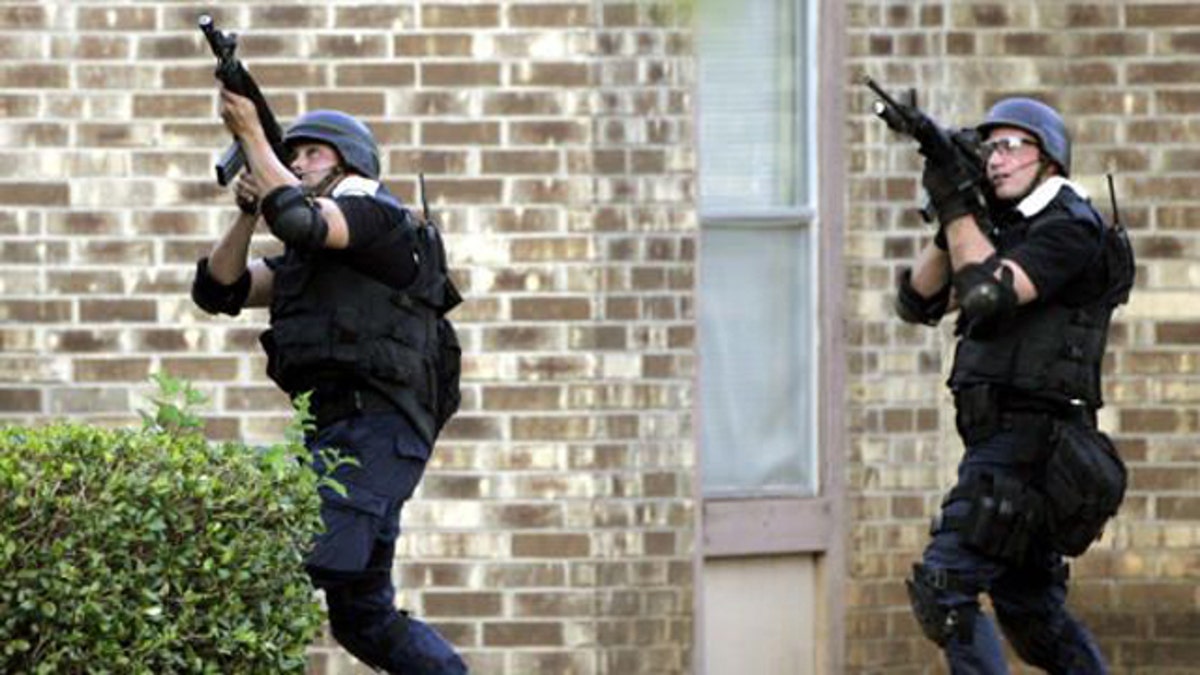
Members of a SWAT unit take aim at a second floor apartment window during a 2006 standoff in which a shooter wounded three police officers and a state trooper. (AP)
Gunshots ring out in the dead of night, and not a single person reports it. Yet police know exactly where the shots came from, even before they arrive on the scene.
It sounds like a scene from The Minority Report, but it's real. A new technology called ShotSpotter enables law enforcement officials to precisely and instantaneously locate shooters, and it has been quietly rolling out across America. From Long Island, N.Y., to San Francisco, Calif., more than 60 cities in the U.S. have been leveraging ShotSpotter to make their streets safer.
Minneapolis has already adopted it. And this past week three more cities from the heartland -- Flint, Mich.; Youngstown, Ohio; and Omaha, Neb. -- have begun testing or furthered plans to roll it out.
The Youngstown Police Department decided to go very public by posting frank warning signs, such as this one at the Youngstown Elementary School:
“If You Fire a Gun, We Will Find You.”
ShotSpotter relies on wide-area acoustic surveillance and GPS technology to triangulate the source of gunshots. Sensors are fixed to buildings and poles to provide coverage over a fixed area. With audio-analysis software, it can identify whether a shooter is stationary or moving -- meaning police officers can be equipped with information on the speed and direction of, say, a vehicle from which a shot was fired.
It can also “hear” the acoustic signature and distinguish between calibers and types of firearms. Similarly, it can hear different explosions and classify them, from vehicle backfires to fireworks to bombs.
The ShotSpotter Gunfire Alert system then relays the location and data to the police or a dispatch computer within moments, enabling a more rapid response time for both police and first responders.
The best part: ShotSpotter works. It's accurate to 10 to 15 feet, and some police departments are reporting accuracy to within five feet. In Long Island’s Nassau County, gun violence was reduced by a whopping 90 percent at the close of this year’s first quarter.
Other countries, including Brazil, have jumped on the ShotSpotter bandwagon. In preparation for the 2014 World Cup and 2016 Olympic Games, Brazil conducted its first live-fire calibration tests this month, using more than 70 hidden sensors in urban areas.
But technology this effective doesn't come cheap. The subscription-based implementation called ShotSpotter Flex costs as much as $60,000 per square mile. Rocky Mount, N.C., uses it monitor a large portion of the city. The Omaha, Neb., police department, which began live-fire testing last week, solved the cost challenge with a grant from the Justice Department.
In many U.S. cities, only a small fraction of gunshots are reported. With this system, created by the 15-year-old Mountain View, Calif., technology firm SST, Inc, police and first responders don't have to rely on citizen reports. Indeed, the time this technology saves can save a life.
The system also lets police identify patterns of gun violence over time. For example, if the system regularly ties a specific house to gunfire, it may flag it as a source of problems. And ShotSpotter can improve criminal forensics, helping boost a prosecutor's case.
Such gunshot-detection systems began to make headway in the ’90s, but false positives have been an ongoing problem. ShotSpotter can be taught sounds and can learn from its mistakes, setting it apart from the pack.
The company also offers a separate gunshot screener product for dispatch centers that improves the rate of accuracy and reduces false positives. The system can transmit a sound to a call center, where acoustics experts can examine the waveform and tell within moments whether it came from a firearm or a firecracker.
Unlike a lot of other wide-area surveillance systems on the market, ShotSpotter doesn't require a clear line of sight and provides much farther range of coverage around a single sensor -- up to approximately one mile unhindered.
ShotSpotting could advance to incorporate surveillance video, so that as a shot is heard and pinpointed, video could document the shooter -- making it easier to identify a suspect and faster to make an arrest. Some police departments have been looking at using Avrio RMS cameras that react to gunfire by spinning toward its source.
Also in the pipeline, SST is developing a wearable gunshot detection system built into a vest, including acoustic sensors, integrated GPS and display.
When gun-wielding miscreants get the message that not only will they be immediately detected but also instantaneously located, shooting that firearm should become a whole lot less appealing.
Ballet dancer turned defense specialist Allison Barrie has travelled around the world covering the military, terrorism, weapons advancements and life on the front line. You can reach her at wargames@foxnews.com or follow her on Twitter @Allison_Barrie




















